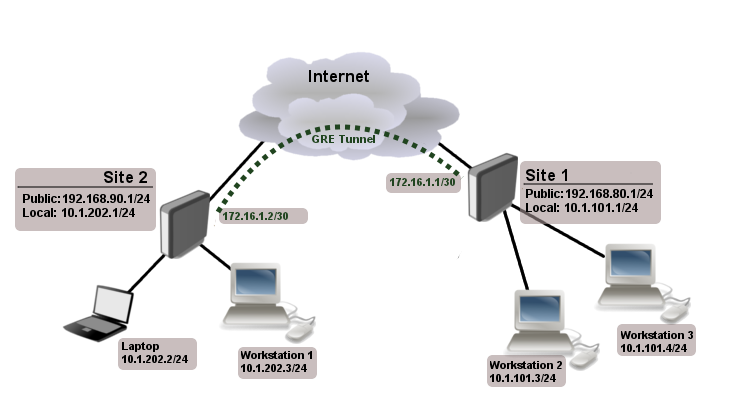Manual:Interface/Gre: Difference between revisions
Jump to navigation
Jump to search
No edit summary |
|||
| Line 86: | Line 86: | ||
==Setup examples== | ==Setup examples== | ||
[[File:site-to-site-gre-example.png]] | |||
{{Cont}} | {{Cont}} | ||
Revision as of 12:03, 16 August 2011
Summary
Sub-menu: /interface gre
Standards: GRE RFC 1701
GRE (generic routing encapsulation) is a tunneling protocol that was originally developed by Cisco. It can encapsulate wide variety of protocols creating virtual point-to-point link.
GRE the same as IPIP and EoIP were originally developed as stateless tunnels. Meaning that if remote end of the tunnels goes down all traffic that was routed over the tunnels gets blackholed. To solve this problem RouterOS have added keepalive feature for GRE tunnels.
Properties
| Property | Description |
|---|---|
| arp (disabled | enabled | proxy-arp | reply-only; Default: ) | Address Resolution Protocol mode |
| comment (string; Default: ) | Short description of the tunnel. |
| disabled (yes | no; Default: no) | Whether tunnel is enabled. |
| keepalive (integer [1..4294967295]; Default: ) | |
| l2mtu (integer [0..65536]; Default: 65535) | Layer2 Maximum transmission unit. |
| local-address (IP; Default: 0.0.0.0) | Ip addres that will be used as local tunnel end. If set to 0.0.0.0 then ip address of outgoing interface will be taken. |
| mtu (integer [0..65536]; Default: 1476) | Layer3 Maximum transmission unit. |
| name (string; Default: ) | Name of the tunnel. |
| remote-address (IP; Default: ) | IP address of remote tunnel end. |
Setup examples
 [ Top | Back to Content ]
[ Top | Back to Content ]
